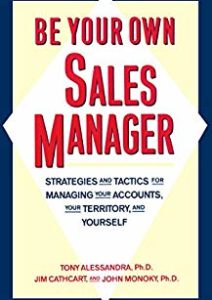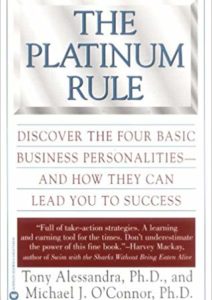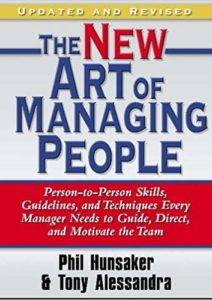Many employers believe that money is the most effective motivator. The problem is that this method gets expensive and doesn’t work as well as positive, non‑monetary motivators. There are other positive motivators that excite many employees even more than money, such as recognition, prestige, achievement, sincere appreciation, pride in a job well done, a voice in how the business is run, responsibility, advancement, and other participative methods that foster a sense of camaraderie and teamwork.
The other side of the motivational coin is negative motivators that rely on instilling fear or insecurity in the employee. Destructively criticizing, belittling, threatening, embarrassing, and baiting the employee all constitute negative motivators. They may “move” the employee to action in the short run, but often have dire intermediate and long-term results on employee attitude, motivation, competence and retention.
Positive motivation leads to a more effective group effort and will increase productivity by building that “can do” team feeling. Motivational experts such as Herzberg, Maslow, Vroom and Hersey agree that employees are motivated more effectively for long-term periods when management uses positive versus negative motivators, non‑monetary versus monetary motivators and personal managerial power versus position power.
Andrew Carnegie was once asked, “Which element was most important for the success of a business: labor, capital or brains?” His reply was a question, “Which leg of a three legged stool is most important?” The three legs of our stool for positively motivated team of employees are:
- Hire the best people.
- Train, train, train.
- Communicate constantly.
These three managerial components set the stage for the appropriate implementation of positive, non‑monetary motivators in the workplace.
Hiring the Best People
When a football coach is hired to push a losing team to victory, he is often faced with problematical variables. The coach may be a fantastic motivator, but the existing team management and players may have opposing views of how to motivate. Often, a changing of the guard is in order ‑ out with the old, in with the new ‑ as others replace the perceived plodders with philosophies similar to the new coach’s. A great coach accompanied by mediocre team talent does not make a winning team. If only one leg of the stool is sturdy, the stool will collapse.
Since the thrust of this blog is on positively motivating current employees–little will be said about the recruiting/hiring phase. It is important, though, because starting with the best people makes the job of motivating easier. Hiring the best people means you can spend less time handling problems and replacing employees that don’t work out because the hiring decision wasn’t well thought out. This gives you more time to do the real work of motivation: training and communication.
Another cost of a poor recruiting program is that you won’t be able to afford top recruits if you have poor productivity and profits from previous bad recruits. The wrong person in the right job simply cannot be motivated for the long‑term, nor can the right person in the wrong job be motivated for the long‑term. It is clear then that a solid recruiting program is an essential leg in the three-legged stool of motivation.
Train, Train, Train
There may be no such thing as the perfect employee, but there are perfectly trainable employees. Ben Franklin once said, “An investment in education pays the best dividends.” It is still true today. The return on your training dollar can be significant, if the training is appropriate, adequate, and properly done.
Appropriate training refers to teaching people the right skills for the job they do. Most companies do a fairly good job with the technical skills, but they forget the people skills and self-management skills that complete the training triangle. Each job requires a slightly different mix of the three skills, but every job requires all three.
People skills include the communication skills of listening, questioning (interviewing), feedback, and other interpersonal skills. Self‑management skills include goal setting, time management, organization, stress management and other self‑directional skills.
Adequate training means ongoing training. Good people cannot be over trained. Once they’ve mastered their job, keep them motivated and growing by cross training. Cross training will keep them from getting bored with the daily repetition and will challenge them to grow and expand their skills. They will have a more “holistic” view of the company, its functions, and its people that will increase their capacity for creativity. When these employees are promoted, they will be better managers because of their higher skill levels and broader view of the company. You set an expectation for constant growth through cross training and encourage your employees to explore the unknown. When market conditions change, you will have more options for shifting staff because of better competence levels in several different areas.
In addition, the opportunities for vertical training to strengthen the organization and motivate employees are often under‑utilized. The most common form of vertical training is delegation, where a manager shares some of his/her responsibilities with direct reports. While this is a very effective method of motivating, it should be taken even further. For example, allow a direct report to actually do your job for a day or a week to get a real feeling for the kinds of decisions you make and the ramifications they have. You might be surprised by some of the creative solutions they come up with to solve your problems. Some companies periodically rotate direct reports through the boss’s job to keep both sides sharper. Often, the boss will trade jobs with a direct report.
Another vertical training opportunity that is often missed is letting an employee work for a while on a job that is “lower” than his/ hers. For instance, a salesperson might work in order entry or order fulfillment (the warehouse) or an accountant could work on the assembly line or drive a truck for a time. The advantages for team building and motivating will surprise you. You’ll be amazed at how your employees will jump at these opportunities if you let them know that their old job will be there when they come back.
Proper training means bite‑sized training with one level of expertise building upon another. The four stages of bite‑sized training are:
- Ignorance ‑ the employee doesn’t know how to do a task or even what the task is.
- Awareness ‑ the employee still cannot do the task, but he knows what is expected of him.
- Practice ‑ the employee makes many mistakes striving to master the details of the task.
- Knowledge ‑ the employee has perfected his performance so that it becomes habitual.
After the employee passes through all four stages of learning a given task, then and only then is he ready for the introduction of another task that is bite-sized and easier to digest. The training leg of the motivational stool is critical because competence creates confidence. You can play a key role here by letting the employees know they’ve done a good job. Confidence is an internal motivator.
Communicate Constantly
Nothing demotivates employees faster than a feeling of being ignored. If they feel that no one cares about them or their contribution to the company, they will “shut down” and do just enough to get by. But if their opinions are sought, they will work enthusiastically to improve productivity and to show their ideas can work. You’ll have a better “team feeling”, management credibility will go up, and you’ll have a better handle on your employees’ current attitudes, motivations and situations. You’ll be in a better position to head off possible problems and conflicts and avoid costly downtime spent handling these situations. You’ll also be in a better position to access the training opportunities discussed earlier.
Constant communication can take many forms. They can include:
- Performance appraisals. Most managers view performance appraisals as a “have to” project, rather than a positive opportunity to review training needs and to set mutual goals for future performance. Appraisals can focus on day-by‑day, minute‑by‑minute feedback on performance aimed at motivation. Positive strokes for positive behavior and additional training for negative behavior is the rule.
- Questioning/Feedback. Ask your employees their opinions on management policy, customer procedures, suppliers, systems and anything else that might improve productivity or morale. Take some time to talk to them about life outside of work as well as their personal philosophies and ideas.
- Future projections. Tell employees what you see in the near and distant future for the company. Talk about new markets and products you’re considering, changes in personnel or procedures, new equipment purchases and anything else you can think of. It is difficult to over inform an employee.
- Listening. When employees talk, pay attention. One idea could be the ticket to the company’s whole future.
- Open door policy. Many ideas have been lost because the process for getting them to the right person was cumbersome. Good ideas should be able to get through immediately. Clear the roadblocks and let the employees know you want their ideas. Then reward them for the ones that are used. Rewards should be given according to the value of the idea.
- WlM Meetings. (Work Improvement Meetings). Treat your employees to breakfast or lunch, with two catches. THEY discuss ways to improve productivity and YOU pay for the meal. This often works well when you can mix people from different work teams, departments, or divisions to get fresh input from those who aren’t mired in detail.
You can make a significant impact on employee morale and productiveness by positively motivating them to do their best. Discover what excites them. Create the proper environment to facilitate the power of positive, non‑monetary motivators.
- Hire the best.
- Train, train, train.
- Communicate constantly.
After you’ve hired the best talent, utilize in-depth, cross and vertical training to maximize individual growth and motivation. Communicate constantly through the use of performance appraisals, questioning/ feedback skills, future projections, listening, open door policy, and work improvement meetings. Your employees share these experiences when you’ve reinforced your three‑legged stool.
Pipeliner CRM empowers sales leaders to train, coach and communicate with confidence. Get your free trial of Pipeliner CRM now.
















Comments